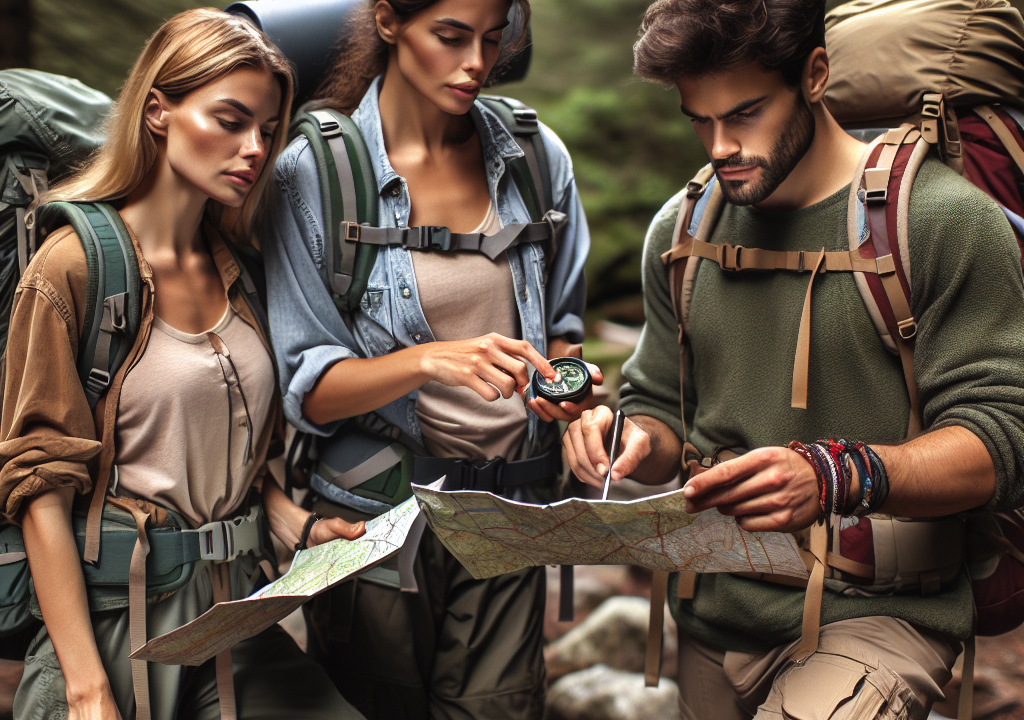
Skills for Thru-Hiking in Snow
Thru-hiking in wintry weather isn’t just a walk in the park. You’ve got to have a certain set of skills, or it’s going to get real icy and not in a fun way. It boils down to two main skills: spotting trouble before it finds you and figuring out the best plan when you’re part of a group.
Keeping an Eye Out for Trouble
Snow can pull some sneaky surprises on you. Picture yourself on those icy slopes or making your wobbly way across a river. There’s also the sun bouncing off the snow, threatening to fry your eyes if you’re not careful.
- Slippery Slopes: Check how steep those snowy hills are before you decide to go skiing without the skis.
- Chilling River Crossings: Think about how deep and fast that river’s running before you end up taking an unwelcome plunge.
- Sun Glare: Protect your eyes from the sun’s rays bouncing off the snow to avoid an unwanted, blinding experience.
- Snow Blindness: Keep those shades on—snow’s glare can mess with your vision if you’re not careful.
According to REI, when it comes to camping in these conditions, don’t just settle for any old tent. Make sure it can handle snow, isn’t too tight, and will keep you comfy for those long-haul hikes.
The Art of Making Good Calls with Your Crew
In groups, coming up with a solid plan is crucial to staying safe:
- Think Outside the Group: Don’t just go along with the crowd, get opinions out there and consider every voice.
- Structure is Key: Have a system in place for deciding what’s what so everyone stays safe.
Moving up to more advanced levels, like joining the ranks of mountain guides (AMGA), requires top-notch training and decision-making skills to guide folks safely through these kinds of challenging conditions.
Mastering how to spot danger and make smart group decisions is a must for any guide put to the test. Nail these, and you not only keep yourself safe, but you figure out how to tackle all sorts of snowy scenarios with ease.
For more tips, mosey on over to our sections on outdoor destinations test, or check out our pieces on backpacking guides test and other nature destinations test.
Preparations for Hiking in Snow
Hazard Identification and Resources
Hitting the snowy trails isn’t just a walk in the park. You gotta be savvy about the stuff that can trip you up—or worse. In heavy snow years, thru-hikers have their hands full, tackling mountains minus clear paths and sizing up risks on the go. Some of the curveballs nature throws include slick slopes, dicey river crossings, harsh UV rays, and the dreaded snow blindness (Treeline Review).
| Hazard | Description |
|---|---|
| Icy Slopes | Slip and slide risk |
| River Fords | Risky business at the best of times |
| High UV Exposure | Burnt skin and fried eyes |
| Snow Blindness | Eyes gone AWOL temporarily |
To keep two steps ahead of trouble, hikers should lean on trusty resources. Check out:
- Local avalanche center websites for snow gossip
- Ranger stations for live intel
- Weather reports to get updates on the fly
With these handy tools, hikers can hit the snow with a game plan, dodging curveballs that snowy terrains might hurl. For more survival tips, hop over to our outdoor destinations test.
Skill Evaluation and Gear Preparation
Sizing up one’s skills against potential hazards is a must-do. Thru-hikers should brush up on their skill set and pack gear that’s worth its weight in gold. Skills up for the challenge? Look out for:
- Tackling those icy inclines
- River fording like a pro
- Spotting and handling snow blindness and UV whammies
Gear must-haves are:
| Gear Item | Purpose |
|---|---|
| UL Crampons | Keep steady on slippery slopes |
| Ice Ax | Don’t lose your footing, literally |
| Warm Layers | Fight the freeze |
| Snow Stakes | Set that tent, rain or… well, snow |
Before setting out, check your gear twice, practice the basics, and make sure you’re rigged up like a pro. This kind of OCD gear check keeps backpacking guides test in shape for snow challenges.
Taking a solid look at their skills and grabbing the right kit ensures hikers have a snowball’s chance in winter wonderland. For more on gearing up, tap into our advice at best gadgets test.
Winter hiking ain’t for the faint-hearted, but with the right mindset, gear, and know-how, anyone can wander the sparkling trails and soak up the magic of snowy trails.
Becoming an AMGA Certified Guide
Path to AMGA Certification
Think you’ve got what it takes to become the mountain whisperer? The American Mountain Guide Certification from AMGA stands as the gold standard for professional mountain guides. This top-tier qualification is your passport to guiding in over 20 countries that recognize its prestige thanks to the International Federation of Mountain Guides Associations (AMGA). Whether you’re scaling rock faces, conquering alpine routes, or cruising down ski slopes, this cert’s got ya covered.
Got stars in your eyes about adventure? Start your road to glory by diving headfirst into climbing and skiing. Get hands-on by learning from the best through guide services or ski schools, or shadow a certified pro to grab some tips and tricks (AMGA). The certificate’s no cakewalk—it takes grit, guts, courses, exams, and lots of elbow grease.
Your journey’s broken into stages, each one upping the ante:
| Certification Stage | Description |
|---|---|
| Core Skills Training | Master the building blocks: technical prowess and playing it safe. |
| Apprenticeship | Cut your teeth under the pros’ guidance. |
| Advanced Training | Get deep on techniques and leadership like a true guru. |
| Assessments | Show off what you’ve learned, practically and theoretically. |
Insights from Experienced Guides
Ever wish you could peek into the minds of those who’ve been there, done that? Certified guides like Paul and Abby offer nuggets of wisdom for anyone itching to kick off their own big adventure. These pros share their paths and fave hanging spots like The Gunks and Joshua Tree (AMGA).
Examples of Professional Insights:
- Paul: Rooted in Mount Desert, ME, Paul’s got the seal of an AMGA Certified IFMGA Guide, specializing as a Certified Single Pitch Instructor. At Acadia Mountain Guides, he dazzles with his climbing know-how and zeal.
- Abby: With a focus on making the great outdoors an open playground for everyone, Abby, also a Certified Single Pitch Instructor, sheds light on the big picture of relationships in adventure sports.
We’ll let you in on a little secret: seasoned mentors can be your secret weapon. Watch their moves, learn from their stumbles, and steal a glimpse at their gear setups for a killer learning experience (AMGA).
Amping up your guiding chops doesn’t end there. Explore productivity apps to boost efficiency, blogger essentials if words are your forte, and check out our outdoor destinations test for extra challenges.
So, ready to chase that dream of becoming an AMGA Certified Guide? It takes a whole lotta hustle, but with a pinch of persistence and a dash of knowledge, your guiding journey promises to be as thrilling as the path itself. Swing by for tips on morning routines test and mindfulness tips test for both life and work glow-ups.
Essential Factors in Backpacking Tents
Picking a backpacking tent is like finding the perfect companion for your outdoor escapades—you want comfort, safety, and a great fit. Let’s talk about what to keep an eye out for: size, how many people it can fit, when you can use it, and how heavy it is.
Tent Capacity and Size Selection
Backpacking tents come in 1- to 4-person sizes. So, aim for a tent that not only fits you and your pals but doesn’t cramp your style. Bigger folks or those who like wiggle room should think about sizing up. Tent interiors can differ big time by brand, so keep that in mind (REI).
| Capacity | Who It’s For | Interior Space Notes |
|---|---|---|
| 1-Person | Lone rangers | Light and cozy |
| 2-Person | Duo explorers | Good middle ground |
| 3-Person | Small groups or spaced-out duos | Roomier but heftier |
| 4-Person | Families or friend squads | Comfy, heavier luggage |
Seasonal Considerations and Weight
Weather plays a big role in which tent is your best buddy. Here’s the scoop on what you might need:
-
3-Season Tents: These are your spring, summer, and fall friends—deal well with rain and a sprinkle of snow. Most folks dig these for their weight and usefulness (REI).
-
4-Season Tents: Tough guys for wild winter gales and snow dumpings. They’re sturdy but add a few pounds.
How heavy your tent is really counts on your load. Ultralight tents cut the flab using tough but light stuff, perfect for those who pack minimalist. But watch out—they might skimp on some swanky extras to save pounds (REI).
| Tent Type | Weight (lbs) | Season Use | Features |
|---|---|---|---|
| Ultralight | 1 – 2.5 | 3-Season | Light, less fancy |
| Lightweight | 2.5 – 4 | 3-Season | Mix of sturdiness and weight |
| 4-Season | 4 – 8 | Any season | Sturdy build, hefty |
Feeling snug is a biggie too. Today’s tents aim for airy, welcoming vibes. Things to ponder include size dimensions, peak height, wall angles, and extras like bright-colored rainflies for more pleasant stays (REI).
For a try-before-you-buy experience, pitch a tent at the store to see its space, height, and wall shape—make sure it’s “the one.”
Your decision on a backpacking tent should weigh up size, seasonal use, weight, and interior comfort. Got itchy feet? Check out our other reads on outdoor destinations and travel must-haves.
Choosing the Right Backpacking Tent
Findin’ that just-right backpacking tent makes all the difference between a memorable adventure and a soggy mess of regrets. In this piece, we’re going over the basics —weight, what it’s made of, coziness, and what it’s got inside.
Weight and Material Considerations
Let’s face it, when you’re trekking through the wild, every single ounce matters. A heavy tent can feel like a ball and chain. You want somethin’ lightweight but tough—kinda like a peanut butter and jelly sandwich for the road, just less sticky. According to folks at REI, the trick is findin’ materials that balance weight and sturdiness.
| Capacity | Typical Weight (pounds) |
|---|---|
| 1-person | 1.5 – 3 |
| 2-person | 3 – 5 |
| 3-person | 4 – 6 |
| 4-person | 6 – 8 |
Here’s what tents are generally made of:
- Nylon: It’s light and strong—your typical overachiever. Sometimes they slap on some silicone or polyurethane so it sheds water like a duck.
- Dyneema Composite Fabric: Fancy name, right? It’s super light and durable, but you might need to break open the piggy bank for it.
- Polyester: A little heavier, but it stays put when wet, which is nice.
For more tips on packin’ light, give this article a look.
Livability and Interior Features
Livability is just a fancy word for “How comfy’s it gonna be when you’ve been cooped up inside for hours?” Some things to think about: the tent floor size, how tall it is, shape of the walls, how many doors it has, and if it’s got spots to stash your gear and let air in.
- Floor Dimensions and Area: It’s a good idea to set up the tent in a store if you can. Crawl in there, see if it feels right.
- Peak Height: Yeah, more height means more room to sit up, but also might add to the weight.
- Wall Shape: Steeper walls mean you get more space inside.
- Doors and Vestibules: More doors mean less time crawling over your buddy to get out. Vestibules give a little extra space for storage.
- Ventilation: Gets the stale air out, keeps things comfy and not damp.
| Feature | Description |
|---|---|
| Floor Dimensions | Bigger floors mean more room to spread out. |
| Peak Height | In 2-person tents, it’s often 36 to 48 inches. |
| Wall Shape | Vertical walls might add weight but give more room. |
| Doors/Vestibules | Easy in and out with extra storage. |
| Ventilation | Look for mesh areas and vents you can adjust. |
Checkin’ these bits off your list will help you snag a tent that really fits your goals—why spend all that dough otherwise? Give it a test-run if you can; nothing beats knowing it’s right for you. For more handy advice, take a peek at our related reads on morning routines test and mindfulness tips test.
Training for Thru-Hiking Success
Thru-hiking ain’t for the faint-hearted. It’s all about prep—body, mind, and what you pack in your bag. Nail this trio, and you might find yourself actually enjoying the long walk!
Physical and Mental Preparation
Hauling yourself across trails like the Appalachian or Pacific Crest requires some serious gumption and grit. Let’s break down the essentials.
-
Cardio Workouts: Think running, biking, or swimming. These activities pump up your heart’s stamina so you can tackle those uphill battles without gasping.
-
Strength Training: Focus on bulking up those legs, back, and core. They’re the muscles pulling you up and over heck knows what on those trails.
-
Keeping Loose: Bend and stretch! Yoga or simple stretches will do the trick, helping you stay limber and dodging injuries.
But hey, muscles only get you so far. Long treks test your brain too. The solitude and length can mess with your head if you let it. Here’s how to stay sane:
- Set Goals: Keep ‘em realistic. It’s more about small wins along the way than finishing in record time.
- Mind Games: Practicing meditation pays off. It can lower stress and keep your head in the game.
- Visualizing the Route: Picture the trail and its surprises. That way the real thing doesn’t hit ya like a ton of bricks.
Curious about more ways to keep your head straight? Check our mindfulness tips test.
Gear Selection and Trail Planning
You can’t just grab any old stuff from your garage. Packing the right gear is like half the battle here.
| Item | Why It Matters |
|---|---|
| Backpack | Get one that’s feather-light but can still take a beating and hold 40-60 liters. |
| Tent | You need something light but ready for whatever weather mishaps you meet. |
| Sleeping Bag | Make sure it can handle the coldest nights you’ll face. |
| Footwear | Your feet are your best buds out there. Treat ‘em to some good hiking boots or shoes. |
| Clothing | Layers matter—think quick-dry, warm and waterproof. |
| Cookware | A light stove, pot, and set of utensils are lifesavers out there. |
| Water Filtration System | Gotta have a trusty water filter, no doubt. |
Want the nitty-gritty on what to throw in your pack? Our travel essentials test got you covered.
Trail Planning
Plotting your path keeps surprises to no more than necessary. Here’s how to map it like a pro:
- Set Your Schedule: Chart a trek timeline, including time to kick back and rest.
- Resupply Points: Pinpoint where you can grab food and stock up along the way.
- Meal Deals: Plan what you’ll eat based on nutrition and ease. You aren’t ordering delivery, after all.
- Water, Water Everywhere?: Know where you can fill up.
- Permits & Rules: Book your passes and make sure you’re not stepping on any regulatory toes.
For extra tricks and tips, poke through our overcoming challenges test.
Follow these steps, and you might just stroll your way to a successful rather than a stress-filled hike, soaking up all the natural wonders these trails throw your way.
















